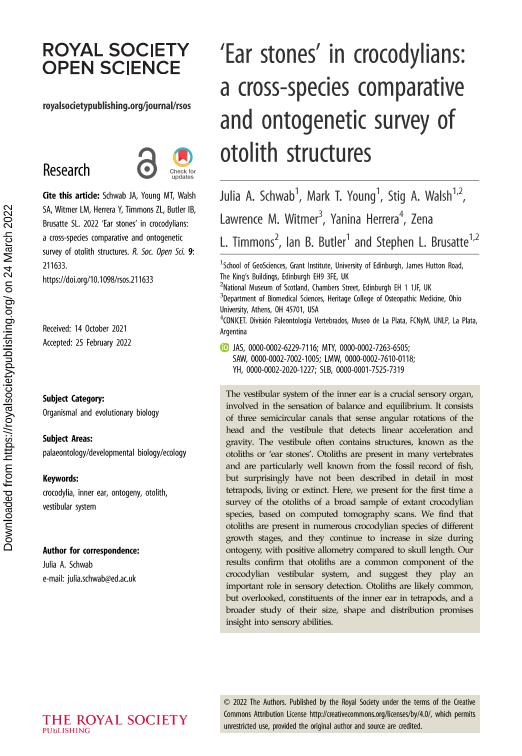Mostrar el registro sencillo del ítem
dc.contributor.author
Schwab, Julia A.
dc.contributor.author
Young, Mark T.
dc.contributor.author
Walsh, Stig A.
dc.contributor.author
Witmer, Lawrence

dc.contributor.author
Herrera, Laura Yanina

dc.contributor.author
Timmons, Zena L.
dc.contributor.author
Butler, Ian B.
dc.contributor.author
Brusatte, Stephen L.
dc.date.available
2023-02-15T11:19:23Z
dc.date.issued
2022-03
dc.identifier.citation
Schwab, Julia A.; Young, Mark T.; Walsh, Stig A.; Witmer, Lawrence; Herrera, Laura Yanina; et al.; Ear stones in crocodylians: a cross-species comparative and ontogenetic survey of otolith structures; The Royal Society; Royal Society Open Science; 9; 3; 3-2022; 1-9
dc.identifier.issn
2054-5703
dc.identifier.uri
http://hdl.handle.net/11336/188054
dc.description.abstract
The vestibular system of the inner ear is a crucial sensory organ, involved in the sensation of balance and equilibrium. It consists of three semicircular canals that sense angular rotations of the head and the vestibule that detects linear acceleration and gravity. The vestibule often contains structures, known as the otoliths or ' ear stones'. Otoliths are present in many vertebrates and are particularly well known from the fossil record of fish, but surprisingly have not been described in detail in most tetrapods, living or extinct. Here, we present for the first time a survey of the otoliths of a broad sample of extant crocodylian species, based on computed tomography scans. We find that otoliths are present in numerous crocodylian species of different growth stages, and they continue to increase in size during ontogeny, with positive allometry compared to skull length. Our results confirm that otoliths are a common component of the crocodylian vestibular system, and suggest they play an important role in sensory detection. Otoliths are likely common, but overlooked, constituents of the inner ear in tetrapods, and a broader study of their size, shape and distribution promises insight into sensory abilities.
dc.format
application/pdf
dc.language.iso
eng
dc.publisher
The Royal Society

dc.rights
info:eu-repo/semantics/openAccess
dc.rights.uri
https://creativecommons.org/licenses/by-nc-sa/2.5/ar/
dc.subject
CROCODYLIA
dc.subject
INNER EAR
dc.subject
ONTOGENY
dc.subject
OTOLITH
dc.subject
VESTIBULAR SYSTEM
dc.subject.classification
Zoología, Ornitología, Entomología, Etología

dc.subject.classification
Ciencias Biológicas

dc.subject.classification
CIENCIAS NATURALES Y EXACTAS

dc.title
Ear stones in crocodylians: a cross-species comparative and ontogenetic survey of otolith structures
dc.type
info:eu-repo/semantics/article
dc.type
info:ar-repo/semantics/artículo
dc.type
info:eu-repo/semantics/publishedVersion
dc.date.updated
2023-02-09T15:49:44Z
dc.journal.volume
9
dc.journal.number
3
dc.journal.pagination
1-9
dc.journal.pais
Reino Unido

dc.description.fil
Fil: Schwab, Julia A.. University of Edinburgh; Reino Unido
dc.description.fil
Fil: Young, Mark T.. University of Edinburgh; Reino Unido
dc.description.fil
Fil: Walsh, Stig A.. University of Edinburgh; Reino Unido
dc.description.fil
Fil: Witmer, Lawrence. Ohio University; Estados Unidos
dc.description.fil
Fil: Herrera, Laura Yanina. Universidad Nacional de La Plata. Facultad de Ciencias Naturales y Museo. División Paleontología Vertebrados; Argentina. Consejo Nacional de Investigaciones Científicas y Técnicas. Centro Científico Tecnológico Conicet - La Plata; Argentina
dc.description.fil
Fil: Timmons, Zena L.. National Museum Of Scotland; Reino Unido
dc.description.fil
Fil: Butler, Ian B.. University of Edinburgh; Reino Unido
dc.description.fil
Fil: Brusatte, Stephen L.. University of Edinburgh; Reino Unido
dc.journal.title
Royal Society Open Science
dc.relation.alternativeid
info:eu-repo/semantics/altIdentifier/url/https://royalsocietypublishing.org/doi/10.1098/rsos.211633
dc.relation.alternativeid
info:eu-repo/semantics/altIdentifier/doi/https://doi.org/10.1098/rsos.211633
Archivos asociados
